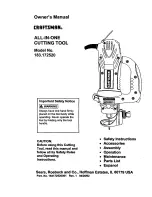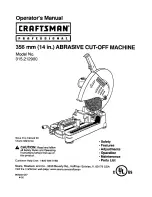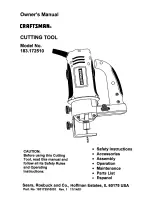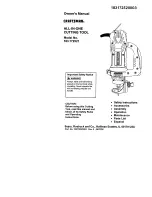
3. Remove the lower rear cover. First move the screws/nuts joining the lower front and rear covers. Then remove the
phillips screws that secure the lower rear cover to the chassis. Allow the lower rear cover to drop until it clears the lower
front cover. Pull the lower rear cover forward and set it aside.
4. There are four screws that secure the nut plate assembly to the front of the slider block. The bottom 2 screws are socket
head (allen) cap screws, one of which also secures a lock washer. The top 2 are cross point screws. Loosen only the cap
screw with the lock washer.
5. The adjustment system is a push/pull arrangement that features Two hex socket screws extend approximately 1/4" from
the side of the block. (push). The other two screws extend through the block and are secured by two nuts. Slightly loosen
the front socket head cap screw that extends from the side of the slider block. Slightly tighten the other front socket head
cap screw that is threaded into the opposite side of the slider block. Tighten the screw until a slight resistance/bind is felt
when manually moving the back gauge. Next, slightly loosen the rear socket head cap screw that extends from the side
of the slider block. Slightly tighten the other rear socket head cap screw that is threaded into the opposite side of the
slider block to obtain smooth movement of the back gauge with no binding. Verify that the back gauge end play is mini-
mal.
6. Retighten the cap screw on the slider block nut plate.
7. Slowly operate the back gauge the full length of travel. Verify that the back gauge does not bind or stall. Repeat the slid-
er block adjustment if necessary.
8. Reinstall the lower rear cover.
9. Reapply power to the cutter.
7.7 Back Gauge Scale Calibration
If the actual cutting distance does not match the scale indicator, proceed as follows:
1. Position the back gauge and cut a minimum of three sheets of stock. Use the middle sheet as the reference for measure-
ment.
2. Check the stock for a square cut. If the cut is not square to 1/64", perform the back gauge squaring procedure in Section
7.5. If the cut is square, proceed to the next step.
3. Turn off power to the cutter. Turn the key switch to the off position (key vertical). Unplug the power cord from the
power outlet.
4. Remove the bottom front and rear chassis covers.
5. Verify the tape cable is tight, no slack in the cable.
6. Loosen the cable locking screw on the side of the slider block. Hold the stand-off with pliers to prevent turning.
7. Move the cable until the correct tape reading is the same as the cut sheet. Tighten the cable locking screw on the side of
the slider block. Make sure the cable is in the groove on the end of the stand-off. Hold stand-off straight with pliers
while tightening.
8. Reinstall the bottom front and rear chassis covers.
9. Reapply power to the cutter.
7.8 Lubrication
The mechanical components of the cutter require periodic lubrication depending upon cutter use. A 30W oil, lithium base
grease, and 90W gear oil are the recommended lubricants. Heavy use is 8,000 or more cutting cycles per week. Moderate
use is 4,000 - 8,000 cutting cycles per week. This schedule is based on heavy use.
Part
Frequency
Lubricant
Tower Rails
Every blade change/monthly
grease
Clamp drive screw
Every blade change/bi-monthly
30W oil
Clamp thrust bearing
Annually
grease
Clamp gear lever pivot pin
Every blade change/monthly
30W oil
Clamp guides
Every blade change
grease
Crank gear/Gear box gear
Bi-monthly
grease
Gear box
Annually
90W oil
Back gauge Acme screw
Monthly
30W oil
All Oilite® bearings
Annually
30W oil
Limit switch bracket pivot pts.
Annually
30W oil
PowerLine Operating Instructions
9
Содержание PL2100
Страница 17: ...PowerLine Operating Instructions 17 Wiring Diagram 1 Clamp and Blade Motor Section Models PL2620 and PL2120...
Страница 18: ...PowerLine Operating Instructions 18 Wiring Diagram 2 Clamp and Blade Controls Section Models PL2620 and PL2120...
Страница 19: ...PowerLine Operating Instructions 19 Wiring Diagram 1 Blade Motor Section Model PL2100...






































